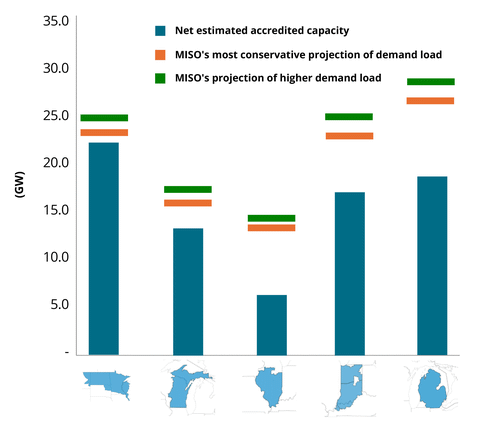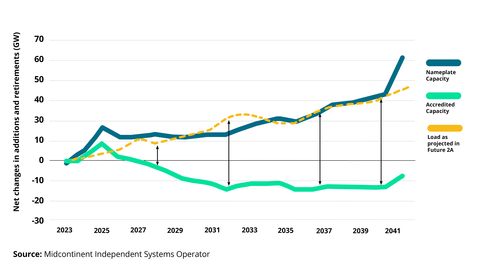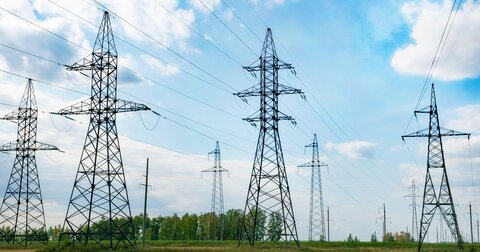Net-zero goals likely to turn off Michigan’s electricity grid
Grid operator projects insufficient electric capacity by 2032
If Michigan continues toward net-zero emissions, it could lose reliable electricity, with a federal regulator and regional electric grid officials warning of substantial energy losses that could come within eight years.
“Net-zero” energy plans in multiple states throughout the Great Lakes region are moving residents and businesses toward a cascading power loss wherein states seek to buy energy from neighboring states, only to find those states have nothing to sell.
That’s according to a study from the Mackinac Center for Public Policy. “Shorting the Great Lakes Grid” is written by research analyst Joshua Antonini and Jason Hayes, director of energy and environmental policy.
The study analyzes the electricity plans of large, investor-owned utilities in seven Great Lakes states: Minnesota, Wisconsin, Michigan, Illinois, Indiana, Ohio and Pennsylvania.
Of the 38 major investor-owned utilities spanning the Great Lakes region, 32 are pledged to be net zero by 2050 or sooner. Of the seven states analyzed in this report, three have net-zero mandates by law, and one has net-zero mandates through regulation. The other three have no net-zero mandates at the state level.
“The problem is the subtraction of dispatchable resources such as coal and gas,” Federal Energy Regulatory Commissioner Mark Christie said during testimony to Congress last year. “The core of the problem is actually very simple. We are retiring dispatchable [quickly launched] generating resources [coal and natural gas] at a pace and in an amount that is far too fast and far too great and is threatening our ability to keep the lights on.”
Grid operators, meanwhile, warn of future shortages and blackouts if states and utilities pursue net-zero goals.
The Midcontinent Independent Systems Operator, the main Midwest grid operator, projects that by 2032, none of the five Great Lakes states in its territory will have enough electricity capacity to meet even the most conservative projection of electricity demands.
 Mackinac Center for Public Policy
Mackinac Center for Public Policy
Net-zero plans require energy producers to build massive amounts of new wind and solar generation facilities. Even with these facilities in place, MISO forecasts, the grid’s total capacity will decrease. That’s because states and utilities are closing coal plants as well as some natural gas and nuclear facilities.
The states and utilities say they will make up the difference with electricity generated from wind and solar. But these sources produce much smaller amounts of energy and are wholly dependent on the weather.
Below, we see MISO’s projections of electric generation capacity from 2023 until 2042. Nameplate capacity — the hypothetical, idealized rated capacity, depicted in blue — increases as utilities build dozens of gigawatts of wind and solar projects. But accredited capacity — the realistic amount reliably generated, shown in green — decreases as dependable coal and nuclear plants close. MISO projects future demand load in yellow on the grid. The nameplate projection hovers around the load projection, suggesting all will be well in a world of net zero. But the chasm between reliable accredited capacity and expected demand means consumer demand for power will increasingly go unmet.
 Mackinac Center for Public Policy
Mackinac Center for Public Policy
The net-zero transition will leave us with less capacity in 2042 than we have now.
“[I]t is not possible to run an electric system — a reliable electric system — on just wind, solar, and storage,” Richard J. Dewey, president and chief executive officer of New York ISO, the grid operator for the Empire State, told the U.S. House Subcommittee on Energy, Climate, and Grid Security.
Most states are moving toward net zero, so Michigan can’t rely on buying surplus energy from neighboring states.
“Are the lights going to stay on? We’re really at a point where that’s coming into serious question,” Federal Energy Regulatory Commissioner Mark Christie told a congressional committee hearing last year. “Are the lights going to stay on?”
Michigan Capitol Confidential is the news source produced by the Mackinac Center for Public Policy. Michigan Capitol Confidential reports with a free-market news perspective.


 EGLE flap leaves 150,000 tons of waste headed for Michigan landfills
EGLE flap leaves 150,000 tons of waste headed for Michigan landfills
 ‘Can’t count on it’: DTE boss says the quiet part out loud on wind and solar
‘Can’t count on it’: DTE boss says the quiet part out loud on wind and solar
 Michigan climate policies only help utility giants
Michigan climate policies only help utility giants